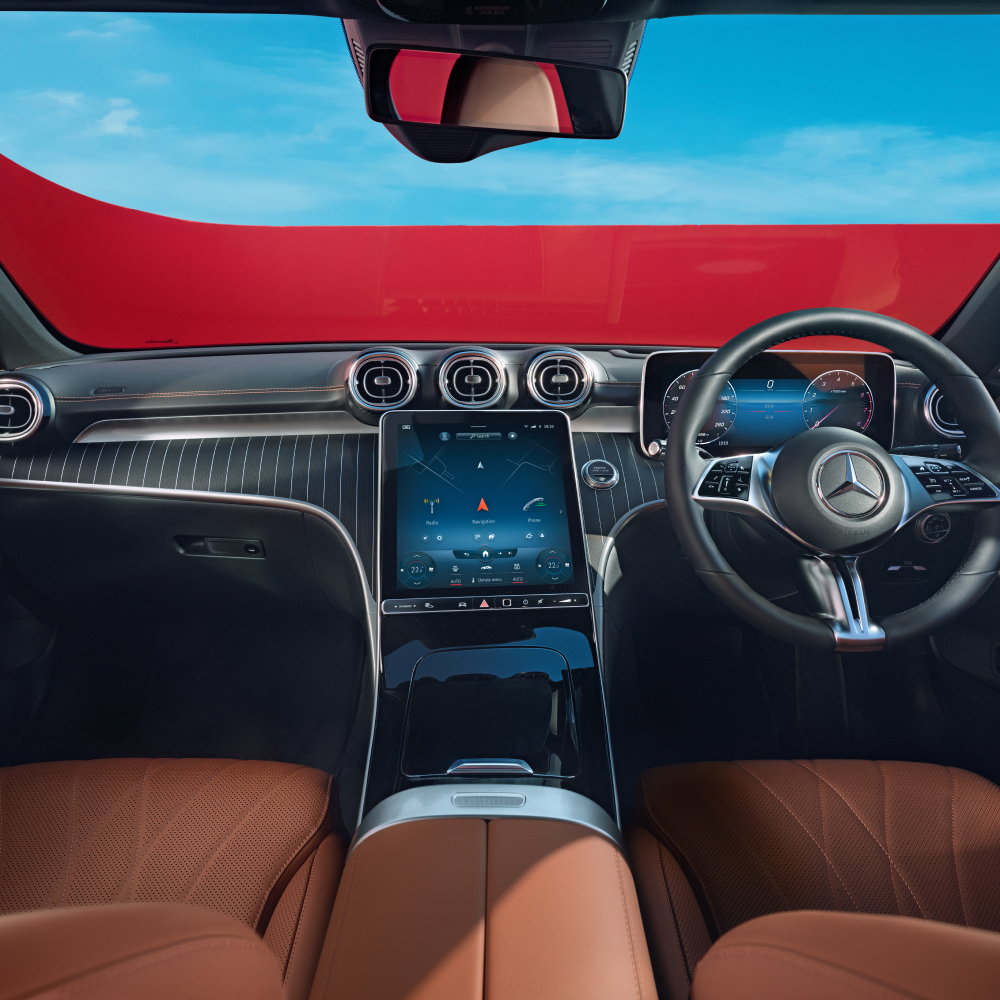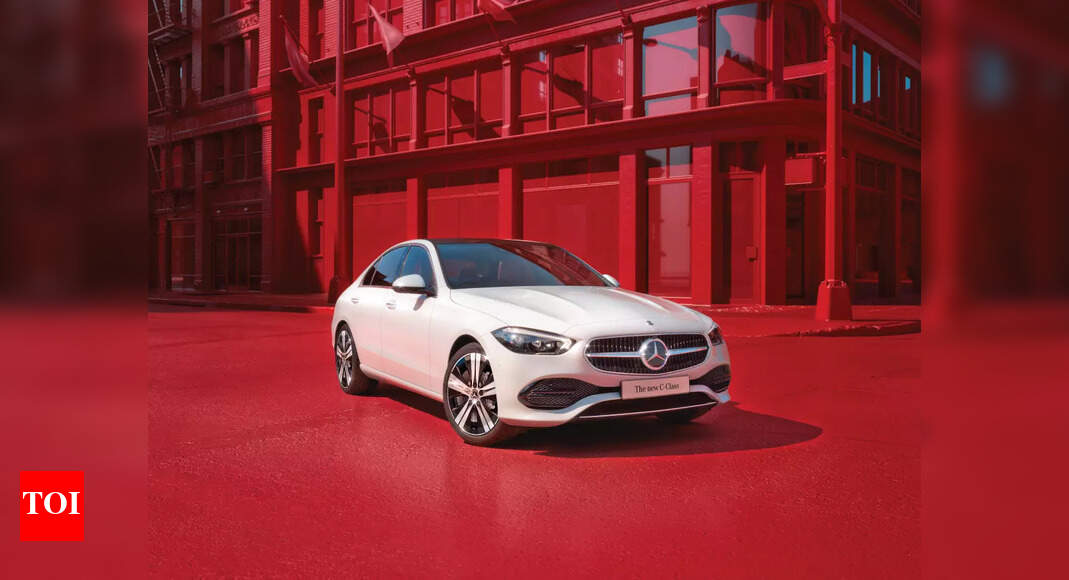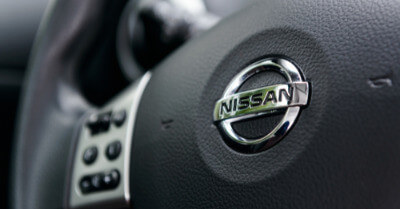You are using an out of date browser. It may not display this or other websites correctly.
You should upgrade or use an alternative browser.
You should upgrade or use an alternative browser.
BRN Discussion Ongoing
- Thread starter TechGirl
- Start date
What, all this fuss for nothingThey put revenue in 4C's these days?
Bravo
If ARM was an arm, BRN would be its biceps💪!
Morning everyone,
I was reading through an article published yesterday about Mercedes' New C-Class (W206) and something popped out at me which is that they refer to the the infotainment system as "MBUX NTG7 infotainment system". I wondered why it would be called NTG7 and came across the HARMAN NTG7 PREMIUM Infotainment System User Manual (link below) which looks like it has only been uploaded to the Harman site in the last week or so.
I haven't had a chance to download the pdf yet to see if there's anything juicy in there, howver at this stage I'm suspecting that Mercedes use Harman for cars that require smaller screens and LG for the much larger Hypercreen, thus the need for the NTG7 distinction??
Extract 1
For years, Mercedes-Benz has been bringing us cars that exude extraordinary design, luxurious comfort and innovative technology features. As the country’s largest and leading luxury carmaker, it has continuously ensured that driving a Mercedes-Benz is an experience in itself by establishing benchmarks on vital fronts of automotive design. Now, once again, the brand has set expectations soaring with the launch of the all-new 5th Generation C-Class that proves itself to be a vehicle par excellence in the luxury sedan segment. The New C-Class (W206) underlines Mercedes-Benz’s significant prowess in creating world-class products, which combines the most desirable package of luxurious comfort and sportiness, in addition to being highly digital and sustainable.
Extract 2
High on technology

The new C-Class adopts its technology prowess from the new S-Class, making it one of the most futuristic cars in the Mercedes-Benz stable. It comes with the MBUX NTG7 infotainment system, which is currently only on the S-Class and the Maybach. It offers enhanced personalization options, intuitive operation, biometric authentication, wireless smartphone integration, Car to X Communication, and over-the-air updates with software that is always kept up to date. With all this and more, there’s so much that the brand-new C-Class allows you to do. [PR(1]
Customers can have up to seven personal user profiles loaded on a vehicle with settings spanning across seat and steering position, ambient lighting setting, AC temperature and mirror settings can be accessed instantly upon login.
The car comes with a hi-resolution central display 30.2 cm (11.9 inch) LCD Touchscreen which is further tilted towards the driver by 6°– 7°. A high quality free, standing driver LCD display of 31.2 cm (12.3 inch) shows you all information in an easy to read format.
To add to the experience, the look of the screen can be individualized with three display styles Classic, Performance and Understated) and three modes (Navigation, Assistance, Service). In " Performance", for example, the colour red is predominant, and the central rev counter has a dynamic design. The full-screen navigation is adapted from the S-Class and gives the driver the best possible guidance on a journey. Additionally, the MBUX navigation helps customer reach their destination safely and quickly. In the C300d, the sound personalization feature is also available where the listening experience can be tailor-made.
Further, the voice assistant "Hey Mercedes" is more advanced and intuitive through activation of online services in the Mercedes me App-thanks to the car’s strong AI operations. The Mercedes Me connect allows the users of the C-Class to stay in touch with other Mercedes vehicles from anywhere around the world and obtain assistance at the touch of a button. To ensure safety & easy access to vehicle information, the Mercedes Me Connect provides some key features such as Vehicle monitoring, Navigation connectivity package, Vehicle set-up, Vehicle finder (enables horn & light flashing), and Geo-fencing.

The recently launched Mercedes-Benz C-Class is grabbing eyeballs for all the right reasons! Here’s why it could change the luxury car segment forever - Times of India
Spotlight News: The recently launched Mercedes-Benz C-Class is grabbing eyeballs for all the right reasons! Here’s why it could change the luxury car segment forevertimesofindia.indiatimes.com

HARMAN NTG7 PREMIUM Infotainment System User Manual
Learn about the technical information, materials and compliance of the Harman NTG7 PREMIUM Infotainment System, including its frequency spectrum and manufacturer, in this user manual. FCC/ISED statements for North America are also provided. Model numbers include T8GNTG7PRE-US and NTG7PRE-US.manuals.plus
Hey Brain Fam,
Sounds like something's afoot with Harman and SoundHound, which is very interesting considering their links with Mercedes' infotainment system (see above).

SoundHound and HARMAN Join Forces to Deliver an Effortless Conversational Voice AI Experience to Auto Customers
SoundHound AI, Inc. (Nasdaq: SOUN) (“SoundHound”), a global leader in voice artificial intelligence, and HARMAN International, a wholly-owned subsidiary of S...
www.businesswire.com
Hawaii is a dangerous place to surf.I was over on the crapper last week, and was reading the last 2 current BRN pages at that time, and a well know serial pest posted about how he had a surfing accident in Hawaii and had hurt his knee and that is why he was posting so much lately. He was chatting with another pest trying to legitimize a bullshit narrative. I think it was quite benign in what was said, but gave the appearance that he was a sincere guy.
I remember reading the exact same thing a couple of years ago on another stock, so think the stories are now being recycled. DYOR
Space Cadet
Regular
Especially
SC
Especially if they come from a real babyBuy her some chocolates.
I was going to say go buy a charcoal smoker and slow cook a rack of baby back ribs, but that'll probably get you in more trouble
SC
Fact Finder
Top 20
Hi @DiogeneseHey Brain Fam,
Sounds like something's afoot with Harman and SoundHound, which is very interesting considering their links with Mercedes' infotainment system (see above).
View attachment 21466
View attachment 21467

SoundHound and HARMAN Join Forces to Deliver an Effortless Conversational Voice AI Experience to Auto Customers
SoundHound AI, Inc. (Nasdaq: SOUN) (“SoundHound”), a global leader in voice artificial intelligence, and HARMAN International, a wholly-owned subsidiary of S...www.businesswire.com
Just looking at the latest patent from Soundhound.
Sorry one minute. Blind Freddie wanted to know how I found a patent and if you sent it to me.
Anyway the following extracted passage suggests to me Soundhound envisage working with whoever is providing Hey Mercedes to Mercedes Benz:
API FOR SERVICE PROVIDER FULFILLMENT OF DATA PRIVACY REQUESTS
Apr 22, 2021 - SoundHound, Inc“Referring now to the block diagram of FIG. 2, once a user 100 issues a privacy request to client device 102, an API according to the present technology is used to implement the privacy request on one or more downstream service providers, such as for example a voice assistant used by the client device 102to improve its voice recognition and natural language understanding with user 100. The downstream service provider 126 may work with one or more affiliates 112 to implement its service to client device 102, as described below.
Referring now to the block diagram of FIG. 3, client device 102 may include a processor 116 configured to control the operations within device 102. The processor 116 may include a standardized processor, a specialized processor, a microprocessor, or the like that may execute instructions for controlling device 102. The processor 116 may be used to implement a human/machine interface (“HMI”) where device 102 can receive audio input from the user 100 via microphone(s) 118, and after processing of the audio input, the device 102 provides feedback to the user via speaker(s) 120. The audio may be processed by speech recognition and natural language processing algorithms resident in memory 122and/or on a remote voice assistant service provider 126. The memory 122may include RAM, ROM, cache, Flash memory, a hard disk, and/or any other suitable storage component. The device 102 may further include communications circuitry such as a network interface 128 for connecting to various cloud resources via the Internet 130. For example, audio input and/or other data and information may be transferred to and from the device 102via the network interface 128connecting to the Internet 130.
The client device 102 may also send and receive data and information to a server 140 associated with the device 102. For example, where the client device 102 is an in-car virtual assistant, the server 140 may be owned or controlled by the car maker or company that provided the car 104 and device 102. The client device 102 and server 140 are together referred to herein as a client device system 142. As noted in the Background section, the company providing or controlling the client device system 142may partner with the service provider 126 to provide services to the client device 102, such as for example voice recognition and natural language understanding capabilities. Thus, the server 140 is also referred to herein as a partner server 140.”
Of course I believe this is definitely Brainchip and AKIDA being the client device they reference where Mercedes’ Benz is concerned.
Any thoughts?
My opinion only DYOR
FF
AKIDA BALLISTA
Bravo
If ARM was an arm, BRN would be its biceps💪!
Here's some more info on SoundHound. I've also pasted the link that opens when you click on "recent contract".Hey Brain Fam,
Sounds like something's afoot with Harman and SoundHound, which is very interesting considering their links with Mercedes' infotainment system (see above).
View attachment 21466
View attachment 21467

SoundHound and HARMAN Join Forces to Deliver an Effortless Conversational Voice AI Experience to Auto Customers
SoundHound AI, Inc. (Nasdaq: SOUN) (“SoundHound”), a global leader in voice artificial intelligence, and HARMAN International, a wholly-owned subsidiary of S...www.businesswire.com
SoundHound and Stellantis Ink Deal Bringing Voice AI to European Autos
Eric Hal Schwartz
on July 14, 2022 at 9:00 am
AddThis Sharing Buttons
Share to Twitter
Share to LinkedInShare to FacebookShare to RedditShare to Email

Automotive giant Stellantis will integrate SoundHound’s voice AI system into several European car brands. The new arrangement comes not long after the company scored a long-term deal with Hyundai, deepening SoundHound’s automotive AI efforts after going public on Nasdaq in April.
Stellantis SoundHound
SoundHound’s new Edge+Cloud system upgrades and streamlines automotive voice AI by processing some commands without needing to send or receive data from the cloud. SoundHound began working with some Stellantis subsidiaries in 2018 when they were part of Groupe PSA, including Peugeot, Citroën, and Vauxhall. Groupe PSA merged with FCA to form Stellantis last year. The new arrangement widens the number and variety of vehicles that will run SoundHound’s technology in Europe far beyond that earlier deal.
The partnership will also mark the first time SoundHound deploys its hybrid cloud and on-device model combining its Edge+Cloud and Active Arbitration technologies to speed the voice assistant’s response time. The new system prompts the car’s AI to respond to driver queries by searching the onboard system and the cloud for a solution at the same time instead of waiting for the on-device search to finish before connecting with the cloud.
“Our partnership with SoundHound began in 2018 with a goal to achieve mass production of voice-enabled vehicles by the end of 2021—starting with our ex-PSA models and then expanding to ex-FCA brands for Europe and China,” Stellantis senior expert for connectivity and infotainment Alexandre Fromion said. “The powerful hybrid cloud and embedded connectivity of SoundHound’s Voice AI platform allows us to deliver always-on voice experiences for customers on-the-go.”
Car Chorus
Stellantis has previously made deals with other voice AI developers besides SoundHound. Amazon signed an agreement with Stellantis to augment its vehicles with Alexa and other Amazon technology starting in 2024. That includes using Amazon Web Services (AWS) as the Stellantis cloud provider and producing the STLA SmartCockpit digital cabin platform, which will make a custom assistant version of Alexa native to 14 major vehicle brands like Dodge and Jeep. This deal was itself an extension of Amazon’s earlier deal with FCA. Amazon’s focus on North American brands wouldn’t overlap with SoundHound necessarily, but Groupe PSA had agreed to use Google’s Android Automotive platform in Europe starting in 2023 pre-Stellantis, so the exact map of voice systems is a little uncertain. SoundHound’s relative flexibility and long experience in voice AI bring some unique benefits to Stellantis. Carmakers using SoundHound can customize the vehicle’s wake word, and the AI will speak around two dozen languages by the end of the year, not all of which are spoken by Alexa or Google Assistant.
“Our long-standing partnership with Stellantis is a direct result of SoundHound’s sophisticated end-to-end solution. It’s a truly disruptive voice AI, and the result of over 17 years of innovation,” SoundHound CEO Keyvan Mohajer said. “Our technology offers companies full control over their brand, user data, and privacy policies, while delivering the greatest value for third-party integration.”

SoundHound's Voice AI is Coming to the Harman Ignite Automotive App Store - Voicebot.ai
SoundHound will integrate its voice AI into the Harman Ignite Store for third-party automotive smart apps. The Samsung subsidiary has..

SoundHound and Stellantis Ink Deal Bringing Voice AI to European Autos - Voicebot.ai
Automotive giant Stellantis will integrate SoundHound’s voice AI system into several European car brands. The new arrangement comes not long..
Deadpool
Regular
I believe I may have seen you there once.Hawaii is a dangerous place to surf.

What's with the nappy?I believe I may have seen you there once.

Hey Brain Fam,
Sounds like something's afoot with Harman and SoundHound, which is very interesting considering their links with Mercedes' infotainment system (see above).
View attachment 21466
View attachment 21467

SoundHound and HARMAN Join Forces to Deliver an Effortless Conversational Voice AI Experience to Auto Customers
SoundHound AI, Inc. (Nasdaq: SOUN) (“SoundHound”), a global leader in voice artificial intelligence, and HARMAN International, a wholly-owned subsidiary of S...www.businesswire.com
Hi Bravo,
This is a recent SoundHound patent application. It's only filed in Japan at the moment, but they have until 10 November to file it elsewhere.
JP2022028772A IN-VEHICLE DEVICE FOR ANALYZING VOICE PRODUCTION BASED ON AUDIO DATA AND IMAGE DATA, METHOD FOR PROCESSING VOICE PRODUCTION, AND PROGRAM
[330 = voice processor which may include NN]
SoundHound combine a lip-reading system with a speech recognition system in this patent.
[0009] In one aspect, the device for the vehicle is an audio interface configured to receive audio data from an audio capture device located in the vehicle and a person in the vehicle to capture image data in the vehicle. It includes an image interface configured to receive image data featuring a face area from an image capture device, and a voice processing module configured to analyze human vocalizations based on audio data and image data. The speech processing module includes an acoustic model configured to process the audio data and predict the phoneme data used to analyze the vocalization, and the acoustic model includes a neural network architecture. The device further includes a speaker preprocessing module implemented by the processor, which is configured to receive image data and obtain a speaker feature vector based on the image data, acoustically. The model is configured to receive speaker feature vectors and audio data as input and is trained to use speaker feature vectors and audio data to predict phonetic data.
[0069] In FIG. 5, the neural network architecture 522 includes at least a convolutional neural architecture. In one architecture, there may be one or more feedforward neural network layers between the last convolutional neural network layer and the output layer of the neural network architecture 522. Neural network architecture 522 may include adapted forms of AlexNet, VGGNet, GoodLeNet or ResNet architectures. The neural network architecture 522 can be replaced in a modular manner as a more accurate architecture becomes available.
They don't mention Akida in their patent specification, but they have left the door open.
Them waves are too big for me.I believe I may have seen you there once.

I get the impression that Akida may be their " Secret Sauce " IP.Hi Bravo,
This is a recent SoundHound patent application. It's only filed in Japan at the moment, but they have until 10 November to file it elsewhere.
JP2022028772A IN-VEHICLE DEVICE FOR ANALYZING VOICE PRODUCTION BASED ON AUDIO DATA AND IMAGE DATA, METHOD FOR PROCESSING VOICE PRODUCTION, AND PROGRAM
View attachment 21474
[330 = voice processor which may include NN]
SoundHound combine a lip-reading system with a speech recognition system in this patent.
[0009] In one aspect, the device for the vehicle is an audio interface configured to receive audio data from an audio capture device located in the vehicle and a person in the vehicle to capture image data in the vehicle. It includes an image interface configured to receive image data featuring a face area from an image capture device, and a voice processing module configured to analyze human vocalizations based on audio data and image data. The speech processing module includes an acoustic model configured to process the audio data and predict the phoneme data used to analyze the vocalization, and the acoustic model includes a neural network architecture. The device further includes a speaker preprocessing module implemented by the processor, which is configured to receive image data and obtain a speaker feature vector based on the image data, acoustically. The model is configured to receive speaker feature vectors and audio data as input and is trained to use speaker feature vectors and audio data to predict phonetic data.
[0069] In FIG. 5, the neural network architecture 522 includes at least a convolutional neural architecture. In one architecture, there may be one or more feedforward neural network layers between the last convolutional neural network layer and the output layer of the neural network architecture 522. Neural network architecture 522 may include adapted forms of AlexNet, VGGNet, GoodLeNet or ResNet architectures. The neural network architecture 522 can be replaced in a modular manner as a more accurate architecture becomes available.
They don't mention Akida in their patent specification, but they have left the door open.
I'm a bit confused. Is it possible that this could be used in lieu of AKIDA or is our tech imbeded in this offering? If it's the latter then how is it that these companies are lauding their innovative brilliance when indeed it's AKIDA that gives them this advantage. Surely at some point BRN is entitled to ask these benefactors to shine some light on their invaluable input. Just wondering if this is what the future looks like for BRN - always the bridesmaid never the bride? 'Look for the revenue' because that's all you'll ever get......It’s a truly disruptive voice AI, and the result of over 17 years of innovation,”
Hi Foxdog,I'm a bit confused. Is it possible that this could be used in lieu of AKIDA or is our tech imbeded in this offering? If it's the latter then how is it that these companies are lauding their innovative brilliance when indeed it's AKIDA that gives them this advantage. Surely at some point BRN is entitled to ask these benefactors to shine some light on their invaluable input. Just wondering if this is what the future looks like for BRN - always the bridesmaid never the bride? 'Look for the revenue' because that's all you'll ever get......
My impression from the JP patent application is that, as of 1 year ago, SoundHound were not using Akida. They talk about CNN but do not mention SNN.
But a lot of water has flowed under the bridge since then. As I said, the patent specification leaves the door open for more accurate neural networks.
Remember, SoundHound may or may not have been party to the Mercedes/BrainChip NDA, which may or may not be the basis of them leaving the door open ... .
Last edited:
Fact Finder
Top 20
Not sure of the accuracy of the information but the Daimler AG connection is interesting given a while back there was a lot of dot joining done around Brainchip and Renault:
Charles Redding
| Article last updated on
September 26, 2022

With an annual production of 2.4 million units and a global market share of 6.2%, Nissan is among the leading automakers. But who owns Nissan? Let’s find out.
Nissan is owned by the Renault-Nissan-Mitsubishi Alliance. This interlocking business arrangement is based on various share allocations with Renault holding 43.4% of Nissan stock, making it the largest shareholder. At the same time, Nissan owns 15% of Renault while Daimler AG owns 3.32% of Nissan.”
My opinion only DYOR
FF
AKIDA BALLISTA
Who Owns Nissan?
byCharles Redding
| Article last updated on
September 26, 2022

With an annual production of 2.4 million units and a global market share of 6.2%, Nissan is among the leading automakers. But who owns Nissan? Let’s find out.
Nissan is owned by the Renault-Nissan-Mitsubishi Alliance. This interlocking business arrangement is based on various share allocations with Renault holding 43.4% of Nissan stock, making it the largest shareholder. At the same time, Nissan owns 15% of Renault while Daimler AG owns 3.32% of Nissan.”
My opinion only DYOR
FF
AKIDA BALLISTA
Bravo
If ARM was an arm, BRN would be its biceps💪!
Here's something new when you click on the latest Mercedes LinkedIn post.




 www.linkedin.com
www.linkedin.com
#mercedesbenz #digitalisation | Mercedes-Benz AG | 12 comments
Today, Digitalisation is omnipresent in our cars and a key driver of our transformation. Connected car services and automated driving make the roads safer and relieve the driver. In order to exploit the full potential of digitalisation, we are actively advocating for certain conditions: 5G...
Space Cadet
Regular
How about
SC
I'M AN AKIDAHOLIC AND PROUD OF IT!How about we make TSE BRN Member T-shirts
SC
Fact Finder
Top 20
I do like this article Bravo but it irks that I cannot extract the part where it specifically references the need to also use "ultrasonic sensors" which as we know a while back just showed up on the Brainchip list of sensor inputs AKIDA could make intelligent and that Valeo at the factory where they are producing Scarla Lidar has stated in a promotional video in the last couple of months that they are also producing "ultrasonic sensors" at this plant for ADAS and AV in the automotive sector.Here's something new when you click on the latest Mercedes LinkedIn post.
View attachment 21479
View attachment 21477
View attachment 21478

#mercedesbenz #digitalisation | Mercedes-Benz AG | 12 comments
Today, Digitalisation is omnipresent in our cars and a key driver of our transformation. Connected car services and automated driving make the roads safer and relieve the driver. In order to exploit the full potential of digitalisation, we are actively advocating for certain conditions: 5G...www.linkedin.com
My opinion only DYOR
FF
AKIDA BALLISTA
mrgds
Regular
I"M AN AKIDAHOLIC AND PROUD OF IT!How about
I'M AN AKIDAHOLIC AND PROUD OF IT!
SC
AKIDAYOUNOT .......................CHEERS
Similar threads
- Replies
- 0
- Views
- 4K
- Replies
- 8
- Views
- 5K
- Replies
- 0
- Views
- 3K
